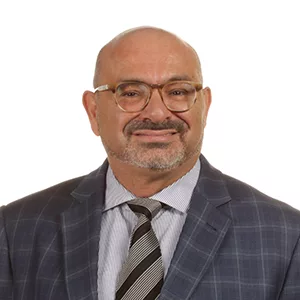Substance Use and Dental Health: What Clinicians Need to Know

Aviv Ouanounou, DDS, MSc, Associate Professor, University of Toronto, Toronto, Canada.
Dr. Ouanounou has no financial relationships with companies related to this material.
CATR: Dr. Ouanounou, I think you are the first dentist interviewed for The Carlat Addiction Treatment Report— welcome! Can you start by introducing yourself?
Dr. Ouanounou: My name is Aviv Ouanounou. I am a Doctor of Dental Surgery and an associate professor at the University of Toronto, where I teach both undergraduate and graduate students in various dental specialties. Some of my areas of interest include the medically complex dental patient, pharmacotherapy in dentistry, and the intersection of substance use disorders (SUDs) and dental care—particularly focusing on the drugs we use, along with their side effects and adverse effects. I also maintain a private practice, which keeps me actively treating patients and up to date.
CATR: How does substance use lead to dental problems?
Dr. Ouanounou: There are several mechanisms by which substance use can lead to dental problems. The first, and probably most problematic, is that many drugs reduce saliva flow, causing what we call xerostomia (dry mouth). Saliva is essential because it contains enzymes and proteins that help control bacteria responsible for tooth decay. When saliva is reduced, the risk of dental caries (cavities) increases. There’s also a notable link between substance use and bruxism (teeth grinding), though the exact mechanism isn’t fully understood. Bruxism can lead to rapid tooth wear, fractures, and dysfunction of the temporomandibular joint. In addition, substance use can lead to periodontal disease, which includes gingivitis and periodontitis. And finally, substance use can cause dental issues indirectly due to inadequate oral hygiene over time. Patients may not be able to care for their teeth properly, may not have access to a dentist, or may not be able to afford one. Unfortunately, I’ve seen many patients with SUDs seek dental care only after their dental issues progress to the point of becoming an emergency, like severe decay or pain. At that point, more extensive procedures might be necessary, such as extractions or root canals.
CATR: Which drugs are most strongly associated with dental issues?
Dr. Ouanounou: Unfortunately, almost all substances are implicated in one way or another. Cannabis, cocaine, methamphetamine, alcohol, and opioids can each cause—or exacerbate—xerostomia. When you have persistent dry mouth, you’re more likely to see an increase in cavities, gum disease, and even, in chronic cases, fungal infections like candidiasis. But of all the substances, methamphetamine is particularly notorious. It can cause severe xerostomia and severe bruxism, and can exacerbate inflammation and infection in the mouth. Vasoconstriction in the gums can lead to periodontal disease, as well. Taken together, methamphetamine can cause extensive dental decay and loss of teeth, often called “meth mouth.” However, whether it’s stimulants, opioids, or alcohol, the common denominators typically include reduced saliva flow, poor nutrition, high sugar intake, and inadequate hygiene.
CATR: How should addiction treatment providers screen patients for dental problems?
Dr. Ouanounou: Begin with a thorough medical and substance use history. You’re probably already asking your patients about which drugs they use and how often, but you can add specific questions that shed light on their oral health and can reveal significant problems early. For example, you can ask whether patients experience dry mouth (a good trick here is to ask if they feel like they need to drink water at night) and whether they notice pain in their teeth or gum bleeding when brushing. (Editor’s note: For more questions to help with assessment, see “Screening Questions for Dental Problems” box.)
CATR: When should we be looking inside our patients’ mouths?
Dr. Ouanounou: A thorough history is probably sufficient in a person who receives regular dental care and does not have any symptoms. But if the patient doesn’t receive regular dental care or if the patient mentions any pain, swelling, or unusual lesions, it’s a good idea to look.
CATR: What should we be looking for?
Dr. Ouanounou: If you see black cavities—particularly on the roots—or black spots around the gum line, that’s a sign of root caries. If the gums are inflamed, bright red, or bleeding easily, that’s indicative of gingivitis or periodontitis. White lesions on the inside of the cheek, which might look like a thick, raised patch, can suggest hyperplasia or leukoplakia, sometimes associated with heavy smoking or alcohol use. If you see any of these, a referral to a dentist on an outpatient basis is warranted.
CATR: And what signs indicate that something more concerning is going on? When should we send a patient to the emergency room?
Dr. Ouanounou: A true dental emergency typically involves swelling, severe pain that doesn’t respond to over-the-counter analgesics, or trismus, which is the inability to open the mouth. If a patient can’t open their mouth, or if there’s swelling of the jaw or face, that may point to a spreading infection that needs antibiotics or surgical drainage. Infections can spread quickly—sometimes to the floor of the mouth, a condition known as Ludwig’s angina, which can become life-threatening. Such dental infections can also spread through soft tissues into the brain, causing abscesses or meningitis. So, if a patient says they have intense pain that keeps them up at night or says they have significant facial swelling, you need to arrange an urgent dental consultation if that’s at all available. If not, you need to send them to an emergency department, preferably one with specialty dental services.
CATR: Let’s pivot to preventive advice. What should we tell our patients about oral hygiene?
Dr. Ouanounou: Basic lifestyle modifications can be very helpful. Staying hydrated and sticking to a diet with fewer refined carbohydrates and sugary foods and drinks can slow down tooth decay. Patients with xerostomia should limit caffeine, antihistamines, and exposure to alcohol—even alcohol-containing mouthwash, which can exacerbate dry mouth. If those lifestyle modifications don’t do the trick, encourage your patients to investigate over-the-counter remedies. We don’t have high-quality evidence for their efficacy, but anecdotally, many of my patients have found them helpful. Biotene and ACT are common brands, but there are many sprays, rinses, and gels available. Finally, for those with severe xerostomia, prescription products such as pilocarpine can be considered.
CATR: What about regular tooth brushing?
Dr. Ouanounou: Yes, of course regular tooth brushing is essential. It’s sometimes easier said than done, but it’s worth reminding patients of basic oral hygiene. Make sure your patient understands the basic dental care recommendations that we should all be following: Brush at least twice a day (ideally for about two minutes each time, making sure to reach every surface) and floss once a day. Remind your patients to schedule routine dental checkups every six months—or even every four months, depending on their risk level—to catch problems early and get professional cleanings. Patients often don’t realize that bacteria in the mouth can travel elsewhere in the body and cause serious complications, so explaining that connection is important.
CATR: We hear a lot about smoking as a risk factor for dental issues, not only with tobacco but also illicit drugs.
Dr. Ouanounou: Research is mixed, but the consensus is that smoking increases dental risks more than other routes of consumption because it directly exposes oral tissues to high temperatures and harmful chemicals. You see higher rates of gum disease, dry mouth, and oral cancers among people who smoke. There’s growing evidence that vaping might be less harmful than smoking cigarettes or other substances, but it’s still not benign. We need more data on the long-term effects, but vaping can still irritate soft tissues, and the vapor might contain chemicals that affect the oral environment.
CATR: The FDA issued an advisory warning that sublingual buprenorphine, but not injectable or transdermal buprenorphine, may be linked to dental problems. Can you explain that?
Dr. Ouanounou: There is concern that sublingual and buccal formulations of buprenorphine are associated with tooth decay and tooth loss. The absolute risk is small, but it was still enough for the FDA to warn about a potential risk (www.tinyurl.com/mpz5w52f). As you know, the advisory was controversial—many professional organizations argued that the analysis was flawed and never should have been published in the first place (www.tinyurl.com/42n4eub8). We don’t know the true extent of the association, but the link is plausible due to buprenorphine’s low pH and its interference with the buffering capacity of saliva. In my view, we should weigh the benefits against the risks. Buprenorphine is a potentially lifesaving tool for treating opioid addiction.
CATR: How should we discuss this with our patients?
Dr. Ouanounou: If a patient is reluctant to start buprenorphine because of the potential link to dental problems, I would first explain that the absolute risk is very small. In addition, a few practical measures can help reduce the risk even further. First, encourage all the dental hygiene tips we already discussed. Second, once buprenorphine has fully dissolved, advise patients to gently rinse with water to wash away any residue and normalize the mouth’s pH. They should also avoid brushing immediately after taking buprenorphine. This may be counterintuitive, but buprenorphine may soften tooth enamel, so brushing immediately can wear away tooth structure. Tell them to wait half an hour or so before brushing.
CATR: Those are helpful tips.
Dr. Ouanounou: Again, basic steps are sometimes all it takes to make a big difference in oral health.
CATR: One trend gaining in popularity is nicotine pouches—often labeled as “tobacco free”—placed in the mouth like chewing tobacco. How do those compare?
Dr. Ouanounou: Nicotine pouches deliver nicotine through the oral mucosa, much like a nicotine replacement approach. There are lots of brands out there—patients may be familiar with Zyn, Sesh, or Lucy. They do not contain tobacco but do deliver potentially high levels of nicotine. Because they don’t have tobacco, it is thought that they are less harmful than chewing tobacco, which carries a high risk of oral cancers and gum recession. However, because a pouch sits against the gum for an extended period, localized plaque accumulation can increase, and that area might see a higher risk of dental decay. Higher doses of nicotine, used frequently, could also have some toxic effect on oral tissues over time, though the precise level of risk isn’t fully established yet. If a person has switched to these pouches from more harmful tobacco products, that’s generally an improvement. But I would still advise them to keep an eye on the area where the pouch is placed, maintain regular dental visits, and keep the mouth as clean as possible.
CATR: Any final thoughts?
Dr. Ouanounou: We all know that dental issues can be a source of significant pain, which can serve as a trigger for those with opioid use disorder. For clinicians in addiction medicine, emphasize that maintaining oral health can reduce the need for opioid pain relief in the first place. Regular checkups and hygiene can prevent emergencies that often end in severe pain and an opioid prescription. Finally, I always stress that good oral health aligns with good general health. If patients know that an infection in the mouth can spread to other parts of the body, such as the heart, and that chronic gingivitis or periodontitis can worsen systemic conditions like diabetes, they may be more motivated to take prevention seriously.
CATR: Thank you for your time, Dr. Ouanounou.
Screening Questions for Dental Problems
- Do you experience dry mouth?
- Do you notice pain in your teeth or gum bleeding when brushing?
- When did you last see a dentist?
- Have you been told you grind your teeth or have you noticed wear or chipping?
- How often do you brush your teeth and floss?
- Do you frequently consume simple carbs and sugary drinks?

Newsletters
Please see our Terms and Conditions, Privacy Policy, Subscription Agreement, Use of Cookies, and Hardware/Software Requirements to view our website.
© 2025 Carlat Publishing, LLC and Affiliates, All Rights Reserved.


_-The-Breakthrough-Antipsychotic-That-Could-Change-Everything.webp?t=1729528747)



